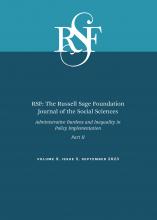Research Article
Open Access
“When Someone Cares About You, It’s Priceless”: Reducing Administrative Burdens and Boosting Housing Search Confidence to Increase Opportunity Moves for Voucher Holders
Stefanie DeLuca, Lawrence F. Katz, Sarah C. Oppenheimer
RSF: The Russell Sage Foundation Journal of the Social Sciences September 2023, 9 (5) 179-211; DOI: https://doi.org/10.7758/RSF.2023.9.5.08
Stefanie DeLuca
aJames Coleman Professor of Social Policy and Sociology at Johns Hopkins University, United States
Lawrence F. Katz
bElisabeth Allison Professor of Economics at Harvard University and a research associate at the National Bureau of Economic Research, United States
Sarah C. Oppenheimer
cExecutive director of Opportunity Insights at Harvard University, United States

REFERENCES
- ↵
- Acosta, Sonya, and
- Eric Gartland
- ↵
- Aiken, Claudia,
- Ingrid Gould Ellen, and
- Vincent Reina
- ↵
- Barnes, Carolyn,
- Sarah Halpern-Meekin, and
- Jill Hoiting
- ↵
- Bergman, Peter,
- Raj Chetty,
- Stefanie DeLuca,
- Nathaniel Hendren,
- Lawrence F. Katz, and
- Christopher Palmer
- ↵
- Bertrand, Marianne,
- Sendhil Mullainathan, and
- Eldar Shafir
- ↵
- Bhargava, Saurabh, and
- Dayanand Manoli
- ↵
- Bigelow, Jonathan
- ↵
- Bouek, Jennifer W
- ↵
- Boyd, Melody, and
- Stefanie DeLuca
- ↵
- Boyd, Melody L.,
- Kathryn Edin,
- Susan Clampet-Lundquist,
- Greg J. Duncan
- ↵
- Briggs, Xavier de Souza,
- Susan J. Popkin, and
- John Goering
- ↵
- Bunger, Alicia, and
- Rebecca Lengnick-Hall
- ↵
- Center on Budget and Policy Priorities
- ↵
- Center on Budget and Policy Priorities
- ↵
- ↵
- Chetty, Raj,
- John N. Friedman,
- Nathaniel Hendren,
- Maggie R. Jones, and
- Sonya R. Porter
- ↵
- Christensen, Julian,
- Lene Aarøe,
- Martin Baekgaard,
- Pamela Herd, and
- Donald P. Moynihan
- ↵
- Chyn, Eric, and
- Lawrence F. Katz
- ↵
- Collinson, Robert,
- Ingrid Gould Ellen, and
- Jens Ludwig
- ↵
- Collinson, Robert, and
- Peter Ganong
- ↵
- Cunningham, Mary,
- Martha Galvez,
- Claudia L. Aranda,
- Robert Santos,
- Douglas A. Wissoker,
- Alyse D. Oneto,
- Rob Pitingolo, and
- James Crawford
- ↵
- Currie, Janet M
- ↵
- Dawson, Rachel Fulcher,
- Melissa S. Kearney, and
- James X. Sullivan
- ↵
- DeLuca, Stefanie,
- Joseph Boselovic, and
- Jasmine Sausedo
- ↵
- DeLuca, Stefanie,
- Susan Clampet-Lundquist, and
- Kathryn Edin
- ↵
- ↵
- DeLuca, Stefanie, and
- Peter Rosenblatt
- ↵
- Devine, Deborah J.,
- Robert W. Gray,
- Lester Rubin, and
- Lydia B. Taghavi
- ↵
- ↵
- Garboden, Philip M. E., and
- Stefanie DeLuca
- ↵
- Garboden, Philip M.E.,
- Eva Rosen,
- Stefanie DeLuca, and
- Kathryn Edin
- ↵
- Hahn, Heather,
- Kathryn Edin, and
- Lauren Abrahams
- ↵
- Herd, Pamela, and
- Donald P. Moynihan
- ↵
- Hirsch, Arnold
- ↵
- Katz, Lawrence F.,
- Jonathan Roth,
- Richard Hendra, and
- Kelsey Schaberg
- ↵
- Lipsky, Michael
- ↵
- ↵
- ↵
- Michalopoulos, Charles,
- Kristen Faucetta,
- Anne Warren, and
- Robert Mitchell
- ↵
- Oreopoulos, Philip, and
- Uros Petronijevic
- ↵
- Owens, Ann
- ↵
- ↵
- Reardon, Sean,
- Kendra Bischoff,
- Ann Owens, and
- Joseph B. Townsend
- ↵
- Reosti, Anna
- ↵
- Rosen, Eva
- ↵
- Rosen, Eva
- ↵
- Rothstein, Richard
- ↵
- Rubinowitz, Leonard S., and
- James E. Rosenbaum
- ↵
- Schwartz, Alex F
- ↵
- Schwartz, Heather L.,
- Kata Mihaly, and
- Breann Gala
- ↵
- ↵
- Soss, Joe,
- Richard C. Fording, and
- Sanford F. Schram
- ↵
- Taylor, Keeanga Yamahatta
- ↵
- Wood, Holly
In this issue
“When Someone Cares About You, It’s Priceless”: Reducing Administrative Burdens and Boosting Housing Search Confidence to Increase Opportunity Moves for Voucher Holders
Stefanie DeLuca, Lawrence F. Katz, Sarah C. Oppenheimer
RSF: The Russell Sage Foundation Journal of the Social Sciences Sep 2023, 9 (5) 179-211; DOI: 10.7758/RSF.2023.9.5.08
“When Someone Cares About You, It’s Priceless”: Reducing Administrative Burdens and Boosting Housing Search Confidence to Increase Opportunity Moves for Voucher Holders
Stefanie DeLuca, Lawrence F. Katz, Sarah C. Oppenheimer
RSF: The Russell Sage Foundation Journal of the Social Sciences Sep 2023, 9 (5) 179-211; DOI: 10.7758/RSF.2023.9.5.08
Jump to section
- Article
- Abstract
- DATA AND METHODS
- DATA
- ANALYTIC APPROACH
- FINDINGS
- WHY IS IT SO HARD TO USE A VOUCHER TO MOVE TO AN OPPORTUNITY AREA?
- WHERE FAMILIES ARE COMING FROM: TRAUMA, HOUSING INSTABILITY, AND SOCIAL SERVICES
- HOW CMTO REDUCED LEARNING AND COMPLIANCE COSTS
- REDUCING PSYCHOLOGICAL COSTS THROUGH HIGH-QUALITY COMMUNICATION
- NAVIGATOR SUPPORT HELPED FAMILIES SEARCH IN OPPORTUNITY AREAS
- DISCUSSION
- CONCLUSION
- Appendix
- FOOTNOTES
- REFERENCES
- Figures & Data
- Info & Metrics
- References
Related Articles
- No related articles found.
Cited By...
- No citing articles found.





